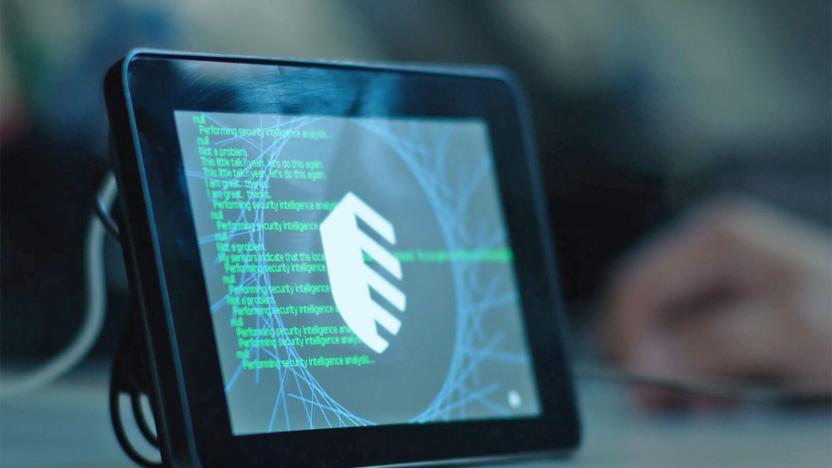CognitiveComputing
Latest

IBM’s Watson is really good at creating cancer treatment plans
Jeopardy-winning Watson is getting better and better at designing cancer treatments. New data presented this week at the American Society of Clinical Oncology's annual meeting show that IBM's Watson for Oncology suggests cancer treatments that are often in-line with what physicians recommend. The company also announced that the cancer care product, designed to help physicians diagnose and treat their patients, is being used by nine new medical centers around the world.

Watson helps treat heart disease by looking at medical images
IBM's Watson technology has helped doctors before, but usually by poring through databases before offering its advice. Now, it's ready to look at the patients themselves -- or rather, their body scans. It's following up on past promises by launching Watson Clinical Imaging Review, its first picture-based cognitive computing solution. The AI platform can sift through ultrasounds, x-rays and other medical data to both fill out health records and identify patients who might need critical care.

Watson-based cancer project paused after running aground
It's tempting to treat IBM's Watson as a cure-all: just throw some cognitive computing at the problem and you'll make everything better. That can only happen if it's well-implemented, however, and we've just seen what happens when things go awry. The University of Texas' MD Anderson Cancer Center has put its highly-touted Watson project (the Oncology Expert Advisor) on hold after an audit discovered both spending issues and an unfocused strategy that didn't meet goals.

IBM's Watson-powered voice assistant is built for security pros
If it wasn't already clear that AI-powered voice assistants are ready for the workplace, it is now. IBM is not only launching Watson for Cybersecurity, a cognitive computing service that parses legions of security reports to extract relevant info, but is unveiling an experimental voice helper to go along with it. Havyn lets digital defense experts ask for threat updates and recommended solutions when it would otherwise be too time-consuming. If security analysts are already hip-deep in work, they don't have to sidetrack themselves with a new research path when Havyn can produce a useful answer in seconds.

GM will use Watson AI to recommend services on the road
Artificial intelligence isn't just being used to automate cars... it's finding a home in conventional cars, too. GM has unveiled a partnership with IBM that will see the Watson cognitive computing platform power OnStar Go, its latest in-car service offering. The AI technology will suggest stores and services based on your location, your decisions and your habits. If you're driving home from work, for example, OnStar can remind you to pick up shopping on the way back. It can also recommend restaurants when you arrive in a new city, or tell you that a store order is ready for pickup.

IBM's supercomputer knows what'll be hot this holiday
After elbowing its way into hospitals and restaurants, it was inevitable that IBM's supercomputer would turn its attention towards the retail business. IBM has launched Watson Trend, a service that harnesses Watson's deep learning smarts in order to discover the hottest and most desirable products to buy this holiday season. The machine will work out what's hot (and what's not) by trawling the web, looking through everyone's public conversations on social media, blog posts and product reviews. Once the information has been found, it'll run sentiment analysis to determine how people really feel about their new smartphones, TVs and tablets to work out the ones folks love the most.

Watson's spicy, ginger-laced gazpacho
'Cognitive Cooking with Chef Watson' is a collaboration between IBM and the Institute of Culinary Education in New York City. Once a week, as part of an ongoing series, we'll be preparing one recipe from the book until we've made all of them. Wish us luck. So this is how I knew I was in trouble the first time I saw Cognitive Cooking with Chef Watson (which, by the way, only happened after I agreed to cook my way through the book): there's a specific section for home cooks and it's only seven recipes long. This particular section of the book is a bit different from the rest. For it IBM partnered with Bon Appétit and trimmed the reservoir of recipes that Watson was riffing off of to just the 9,000 or so already in the publication's database. The results are much more friendly for those that don't have access to an commercial kitchen, but they're no less interesting from a flavor profile and serve as evidence that even mortal humans can benefit from Watson's creative kick in the pants.

Watson's South American spin on a Canadian classic
'Cognitive Cooking with Chef Watson' is a collaboration between IBM and the Institute of Culinary Education in New York City. Once a week, as part of an ongoing series, we'll be preparing one recipe from the book until we've made all of them. Wish us luck. So far we've just been working from the front of Cognitive Cooking with Chef Watson, towards the back. But we're going to start jumping around a bit now. Partially for convenience sake (it's just easier to make all three poutine recipes in a row), but mostly because I want to avoid using my oven as much as possible. It's hot and humid in New York and I live in a small one bedroom apartment. Basically just looking at my oven makes the temperature rise about 20 degrees in here. So we're jumping a few recipes ahead to take on the Peruvian Potato Poutine, a South American twist on a Canadian classic. This is one of the recipes that Watson inspired the chefs from the Institute for Culinary Education to whip up at SXSW in 2014 at their cognitive computing food truck. So, you can sort of think of this as a Chef Watson 1.0 dish.

Cooking with Watson: Caymanian Plantain Dessert
Cognitive Cooking with Chef Watson is a collaboration between IBM and the Institute of Culinary Education in New York City. Once a week, as part of an ongoing series, we'll be preparing one recipe from the book until we've made all of them. Wish us luck. So for the second week in a row, Watson and his culinary interpreters are appealing to my sweet tooth. Except, where last week's pastries had a savory backbone to keep things interesting, the Caymanian plantain dessert is a full-on tooth-rotting sugar bomb. And a damn delicious one at that. Here's the thing about IBM's cognitive computing project: You never know quite what you're going to get. On the surface the list of flavors here seems like an obvious combination, but as chef Michael Laiskonis points out in the accompanying notes, it's in how they all come together. See Watson isn't just about jamming together seemingly incongruous ingredients. The idea is to push human creativity, in whatever area that may be. It just so happens that in this case IBM is trying to broaden your kitchen vocabulary.

Cooking with Watson: Spanish almond crescent
Cognitive Cooking with Chef Watson is a collaboration between IBM and the Institute of Culinary Education in New York City. Once a week, as part of an ongoing series, we'll be preparing one recipe from the book until we've made all of them. Wish us luck. Watson's latest challenge to my self-esteem and sanity, the Spanish almond crescent, is the first dessert in the Cognitive Cooking book. And it's an incredibly challenging one. But, I'll say this up front, if you put in the effort, the payoff is well worth it. These pastries are quite unique and delicious. They're not so surprising that the first bite catches you off guard, like say last week's Swiss-Thai asparagus quiche. But that's a good thing. These little puffs of sweet and savory are different, but approachable; unfamiliar, but comforting.

Cooking with Watson: Swiss-Thai asparagus quiche
Cognitive Cooking with Chef Watson is a collaboration between IBM and the Institute of Culinary Education in New York City. Once a week, as part of an ongoing series, we'll be preparing one recipe from the book until we've made all of them. Wish us luck. Another week, another quiche. I can't say I went into this one with high hopes after last week's funky salmon number. But, at least there is no fish here. Instead you've got a dash of Southeast Asian flavors, some asparagus and a buttery, flaky crust. This is pretty much a variation on the formula that produced Watson's biggest success, the turmeric paella -- combine the flavors of one region, with the presentation of another, and voilà! The Swiss-Thai asparagus quiche puts the flavors of Thailand (and a hint of Greece) in an open-top custard pastry often associated with French cuisine. And once again, IBM's cognitive computing efforts succeed in pushing its human chef interpreters to make something unique.

Cooking with Watson: Scandinavian salmon quiche
Cognitive Cooking with Chef Watson is a collaboration between IBM and the Institute of Culinary Education in New York City. Once a week, as part of an ongoing series, we'll be preparing one recipe from the book until we've made all of them. Wish us luck. Sometimes, the ingredient lists for these Watson recipes read like a Chopped contestant's worst nightmare. Inside the basket you will find: tart shells, gruyere, sour cream and salmon filets. Almost any time you mix cheese and fish, you know you're in trouble. (Update: I acknowledge that both tuna melts, and bagels with cream cheese and lox are rare exceptions to this rule.) But, if anyone is capable of taming the culinary cruelty of Watson it would be the brilliant minds at the Institute of Culinary Education, like Florian Pinel and Michael Laiskonis. So, even though the idea of a Scandinavian salmon quiche is a little off-putting, I put my faith in the human interpreters to steer me and my captive taste testers in the right direction.

I trusted my gut to IBM's Watson and it gave me a fowl old-fashioned
Cognitive Cooking with Chef Watson is a collaboration between IBM and the Institute of Culinary Education in New York City. Once a week, as part of an ongoing series, we'll be preparing one recipe from the book until we've made all of them. Wish us luck. Before taking the helm at Vogue, where she laid the groundwork for the Devil to wear Prada, Diana Vreeland wrote a series of columns for Harper's Bazaar called "Why Don't You?" In a sort of goop for the 20th century, she would goad the super rich into ridiculous feats of capitalism. "Why don't you rinse your blond child's hair in dead champagne to keep it gold, as they do in France?" she'd ask. Or, "Have your bed made in China -- the most beautiful bed imaginable, the head board and spread of yellow satin embroidered in butterflies, alighting and flying, in every size and in exquisite colors?" Watson seemed to be channeling Ms. Vreeland in Cognitive Cooking, a collaboration between IBM's supercomputer and a group of humans at the Institute of Culinary Education (ICE). "Why don't you make an old-fashioned with a splash of chicken broth and a slice of grilled chicken for garnish?" it inquired. And in the spirit of excess we did just that.

Cooking with Watson: Italian grilled lobster
'Cognitive Cooking with Chef Watson' is a collaboration between IBM and the Institute of Culinary Education in New York City. Once a week, as part of an ongoing series, we'll be preparing one recipe from the book until we've made all of them. Wish us luck. I've got to say I am pretty against the idea of wrapping lobster in bacon. While, yes, bacon does tend to make everything better, I'm also a bit of a purist. I don't like butter or onions in my hamburgers, or mignonette on my oysters. These are foods meant to be enjoyed as they are. And I feel the same about lobster. It is meant to be steamed and devoured as is (or with some drawn butter and lemon if you really must). But, I have a job, and right now that job is to cook whatever Watson tell me to. So it's time to defile one of the most delicious (and expensive) sea creatures with bacon and a lot of citrus.

Cooking with Watson: Indian turmeric paella
'Cognitive Cooking with Chef Watson' is a collaboration between IBM and the Institute of Culinary Education in New York City. Once a week, as part of an ongoing series, we'll be preparing one recipe from the book until we've made all of them. Wish us luck. So, here's a question: Is it still a paella if it doesn't involve olive oil or saffron, and doesn't generally represent the flavors of Spain? At what point does it become a pilaf or, since this particular recipe is brimming with spices from the Indian subcontinent, a biryani? Really the only discernible quality that this Indian turmeric paella has that screams "paella" is the presence of socarrat -- the toasty, browned rice that sits at the bottom of the pan. Oh, and the presentation. And so, here we go again, Watson and his human interpreters from the Institute for Culinary education take a seemingly familiar dish and, with a little computer-generated nudge, create something wholly unfamiliar.

Cooking with Watson: Turkish Bruschetta with carrot pearls
'Cognitive Cooking with Chef Watson' is a collaboration between IBM and the Institute of Culinary Education in New York City. Once a week, as part of an ongoing series, we'll be preparing one recipe from the book until we've made all of them. Wish us luck. Let's get a couple of things straight: Watson, the IBM supercomputer famous for spanking Ken Jennings on Jeopardy, did not really write these recipes in the purest sense of the word. Rather, IBM trained it by feeding it a giant database of recipes, studies on what flavors and smells people find pleasant and information on the chemical compounds found inside ingredients. Using this, Watson is able to suggest dishes with surprising flavor combinations. From there the computer passes the baton to a human being, in this case James Briscione and Michael Laiskonis from the Institute of Culinary Education (ICE), who use the ingredient lists and style suggestions as inspiration for new dishes.

IBM's Watson cognitive computer has whipped up a cookbook
IBM's Watson learning computer system isn't just content with making the occasional meal -- it has a whole slew of recipes lined up. The tech company is launching Cognitive Cooking with Chef Watson, a cookbook based on Watson's knack for combining food in a way that produces unique (and typically tasty) flavors. There's only about 65 foodstuffs in the mix, but they're considered "greatest hits" that should work well in real life. Just be prepared to do more grocery shopping than usual when the book arrives on April 14th, since IBM's machine tends to choose ingredients that you probably don't have in the pantry.

Qualcomm's next chips will help smartphones think for themselves
Qualcomm teased the prospect of smartphones that learn a couple of years ago, and it's now much closer to making them a practical reality. The chip designer has revealed its next big mobile processor, the Snapdragon 820, will be one of the first that can handle its Zeroth cognitive computing platform. In short, it'll let your phone learn about you (and the world around you) to take action on its own. You should see photo apps that detect whole scenes, security tools that protect against unknown viruses and interfaces that depend more on expressions and head movement than button taps. It gets more ambitious than that, though. Zeroth allows for always-on sensors that detect your surroundings (such as through motion or sound) and help your phone anticipate what you want.

IBM's Watson supercomputer will help you cook in this new recipe app
Conventional recipe apps are all well and good if you're not sure what to eat in the first place, but what if you're looking to experiment? IBM thinks its Watson supercomputer can offer some advice, so it's teaming up with the editors at Bon Appétit to test Chef Watson, an app that leans on the cognitive machine's food-making skills to spice things up. Rather than make you choose from a small, predefined set of recipes, you set some criteria and let Watson do most of the hard work; it produces 100 meal suggestions based on both the ingredients you've allowed and the cooking styles you'd prefer.

IBM Research reveals new silicon chip foundation inspired by the human brain (video)
The brain is an incredibly complicated thing, so much so that scientists have spent years trying to decipher its inner workings. IBM is one such institution attempting to crack the code of the human mind. In collaboration with DARPA's SyNAPSE program, it developed a "neurosynaptic computing chip" back in 2011 designed to simulate some of the brain's functions and successfully simulated 530 billion neurons last year thanks to the world's second fastest supercomputer. Today, the company unveiled an important next step in this quest with a new software ecosystem made to program silicon chips that would closely emulate the brain's low power and compact volume. Some of the discoveries in the new ecosystem include a multi-threaded software simulator, a neuron model that supports wide-ranging neural computations, and programs made out of "corelets," building blocks that represent neurosynaptic network blueprints. It's quite a lot to grasp to be sure, so we've embedded a video after the break of IBM explaining the possible applications of its research. As for the scientifically-minded amongst you, feel free to peruse the press release for more details on IBM's latest breakthrough in cognitive computing.





